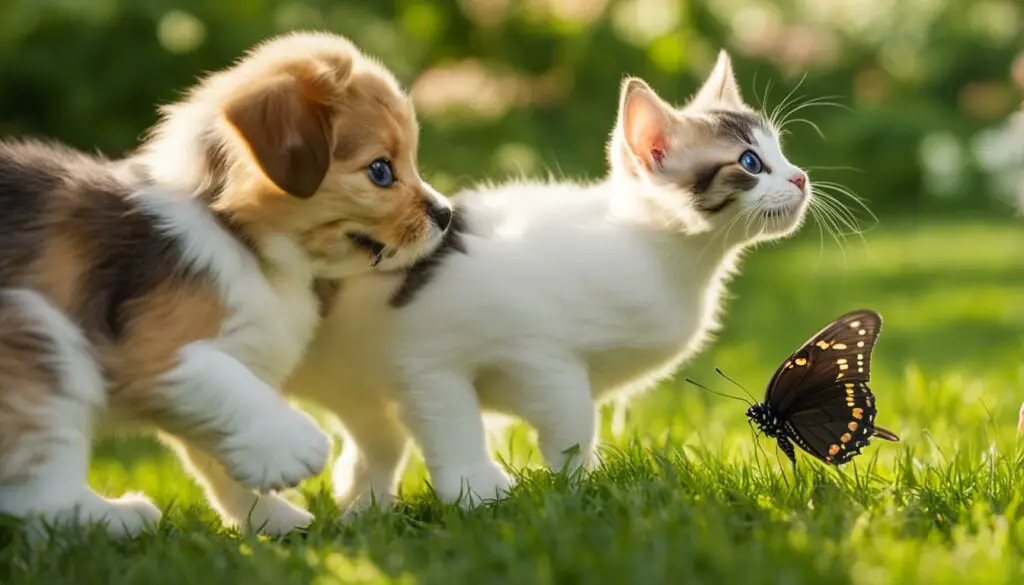I often hear pet owners ask the question, “Will my cat and dog ever get along?” It’s a valid concern, as bringing two different species together under one roof can be a challenge. However, it’s important to understand that while it may take some time and effort, it is indeed possible for cats and dogs to develop a harmonious relationship.
When it comes to the compatibility and interaction between cats and dogs, there are a few key factors to consider. Each pet has its own unique personality, and their individual compatibility plays a significant role in determining whether they can coexist peacefully. Additionally, the way they are introduced and managed by their owners also greatly influences the success of their relationship.
In this article, I will address common queries regarding the relationship between cats and dogs, exploring their compatibility, introducing them to each other, and providing tips and guidelines to help foster a positive bond between your furry friends.
Key Takeaways:
- Cats and dogs can have a harmonious relationship, but it depends on their individual personalities and the way they are introduced and managed.
- Compatibility between cats and dogs is crucial for a positive coexistence. Consider the temperament and energy levels of both pets when introducing them.
- There are certain dog breeds known for being more compatible with cats. Golden Retrievers, Pugs, and Basset Hounds are examples of cat-friendly breeds.
- Gradual introductions, allowing pets to familiarize themselves with each other’s scent and providing separate spaces, are essential for a successful relationship.
- Proper training, exercise, and providing separate resources help minimize conflicts and ensure a peaceful coexistence between cats and dogs.
Do Cats And Dogs Get Along? Exploring Compatibility
When it comes to cats and dogs, one of the most common questions people have is whether they can get along. The answer lies in the compatibility of their personalities and how they are introduced and managed by their owners. Understanding the adjustment process and taking the necessary steps can lead to a positive relationship between these two pets.
Compatibility is a crucial factor in determining whether cats and dogs can coexist peacefully. Just like humans, animals have their own unique personalities. It’s important to consider their individual traits when introducing a cat and dog into the same household. For instance, an older, relaxed pet may find it challenging to adjust to the presence of a new energetic kitten, while a boisterous dog may not be the best match for a nervous cat.
Introducing a cat and dog requires patience and careful management. Gradual introductions can help them become familiar with each other’s presence and reduce the chances of conflicts. Start by allowing them to get familiar with each other’s scent by swapping blankets or using scent diffusers. Provide separate spaces for each pet and gradually allow controlled visual interactions. This process helps them adjust to the new dynamic and increases the likelihood of a harmonious coexistence.
Creating a Cat-Dog Compatibility Chart
| Personality Trait | Cat | Dog |
|---|---|---|
| Energy Level | Low/Medium/High | Low/Medium/High |
| Socialization | Independent/Friendly/Social | Independent/Friendly/Social |
| Tolerance | Low/Medium/High | Low/Medium/High |
“Compatibility is a crucial factor in determining whether cats and dogs can coexist peacefully.”
Understanding the compatibility of cats and dogs is vital for creating a harmonious environment for both pets. By considering their personalities, following proper introductions, and providing separate spaces, owners can increase the chances of a successful coexistence. Each cat and dog is unique, so taking the time to understand their individual needs is key to fostering a positive relationship between these beloved pets.

Dog Breeds That Can Live With Cats: Exploring Cat-Friendly Dogs
While all dog breeds have the potential to get along with cats, there are certain breeds that are known for being more compatible with feline friends. These cat-friendly dog breeds have personalities that are better suited for living harmoniously with cats:
Golden Retrievers
Golden Retrievers are known for their friendly and gentle nature. They are generally good-natured and patient, making them a great choice for families with cats. Golden Retrievers are adaptable and can easily adjust to living with a feline companion. They tend to be tolerant of cats and are less likely to exhibit aggressive behavior.
Pugs
Pugs are small-sized dogs with a playful and sociable temperament. They have a friendly and easygoing nature, making them well-suited for living with cats. Pugs are known to form strong bonds with their human family members as well as other animals. Their calm and affectionate demeanor can help create a positive relationship with a cat.
Basset Hounds
Basset Hounds are known for their laid-back and relaxed personality. They have a gentle and easygoing nature, which makes them a good match for living with cats. Basset Hounds are typically non-aggressive and are more likely to get along well with other animals. Their calm demeanor can help create a peaceful coexistence between a cat and a dog.
When considering adding a dog to your cat household, it’s worth considering these cat-friendly dog breeds. However, it’s important to remember that individual personalities and proper introductions are key factors in ensuring a successful relationship between a cat and a dog.
| Golden Retrievers | Pugs | Basset Hounds |
|---|---|---|
| Friendly and gentle | Playful and sociable | Laid-back and relaxed |
| Tolerant of cats | Forms strong bonds | Non-aggressive |
| Adaptable | Calm and affectionate | Easygoing |
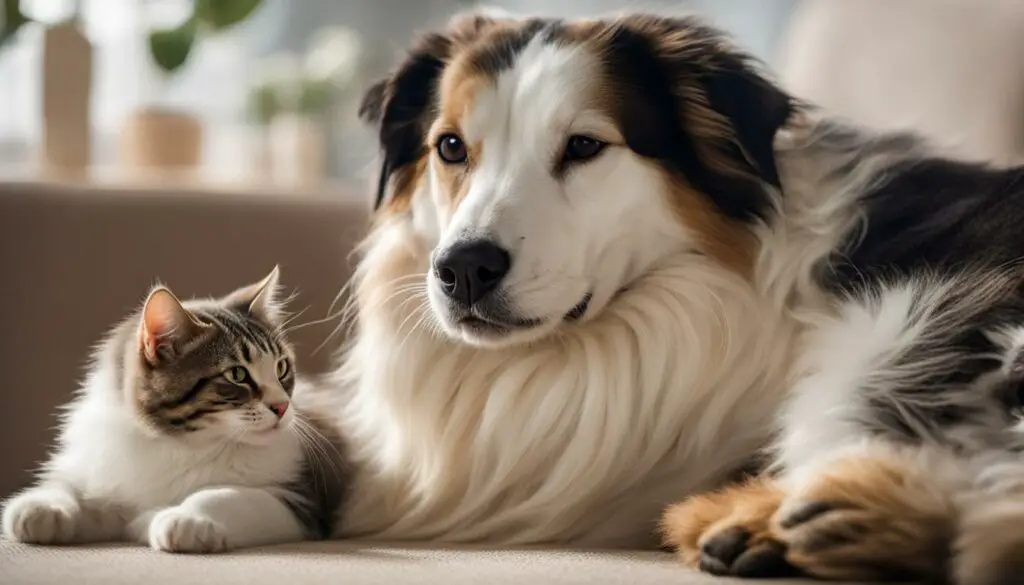
“The key to a successful relationship between a cat and a dog is finding animals whose personalities are compatible. While certain dog breeds may have traits that make them more cat-friendly, it’s important to remember that individual temperament and proper introductions are crucial for a harmonious coexistence.”
How To Introduce Your Dog and Cat to Each Other: Step-by-Step Guide
Introducing a new dog to a resident cat requires a gradual and careful approach. By following a step-by-step process, you can help ensure a smooth and positive transition for both pets. It’s important to remember that every cat and dog is unique, and the timeline for their introduction may vary. Patience and consistency are key to fostering a healthy relationship between your cat and dog.
Gather Scent
Before the initial face-to-face meeting, start by allowing your cat and dog to get familiar with each other’s scent. You can accomplish this by swapping blankets or using scent diffusers. This helps both pets become accustomed to each other’s presence and reduces stress during their first meeting.
Create Separate Spaces
Providing separate spaces for your cat and dog is crucial during the introductory phase. This helps each pet feel comfortable and secure while gradually adjusting to the presence of the other. Consider setting up a cat tree or platforms for your cat, and designate a separate location for your dog’s food and water. These separate spaces ensure that both pets have their own safe areas.
Controlled Visual Interactions
Once your cat and dog have become accustomed to each other’s scent and have settled into their separate spaces, you can start allowing controlled visual interactions. This can be done by keeping them separated by a door or dog gate. Visual interactions should be gradual and supervised, with a focus on keeping both pets calm and relaxed. This step allows them to observe each other without direct physical contact.
Remember, the introduction process may take time, and it’s important to prioritize the safety and comfort of both your cat and dog. With patience, consistency, and proper management, you can help facilitate a positive and harmonious relationship between your cat and dog.
Ensuring a Positive First Meeting: Tips for a Successful Introduction
When it comes to introducing your cat and dog for the first time, careful planning and supervision are key to ensuring a positive experience. By following these tips, you can help create a harmonious relationship between them:
- Keep them separated initially: For the first few days, keep your cat and dog in separate parts of the house. This allows them to become familiar with each other’s scents without direct contact.
- Gradual visual interactions: Start by allowing them to see and smell each other through a door. You can place their food bowls on either side of the door to associate each other’s presence with positive experiences.
- Use a dog gate for controlled interactions: Once they are comfortable with visual interactions, you can begin using a dog gate to allow closer contact. Keep the dog on a leash during these initial meetings to maintain control.
- Ensure the cat feels secure: It’s important to prioritize the comfort and security of your cat during the introductions. Make sure they have access to high spaces, such as a cat tree or shelves, where they can observe and retreat if needed.
- Show equal affection to both pets: It’s essential to give equal attention and affection to both your cat and dog during this process. This helps prevent jealousy and ensures that both pets feel loved and valued.
Remember, every pet is unique, and the timeline for successful introductions may vary. Be patient and allow them to adjust at their own pace. If needed, consult a professional animal behaviorist or veterinarian for personalized guidance.
Following these tips and taking the time to introduce your cat and dog gradually can greatly increase the chances of a positive first meeting. By setting the stage for a harmonious relationship from the start, you can help create a lasting bond between your pets.
| Positive Experience | Negative Experience |
|---|---|
| Relaxed body language | Stiff or tense body language |
| Curiosity and interest | Aggression or fear |
| Sniffing and investigating each other | Growling or hissing |
| Playful interactions | Chasing or swatting |
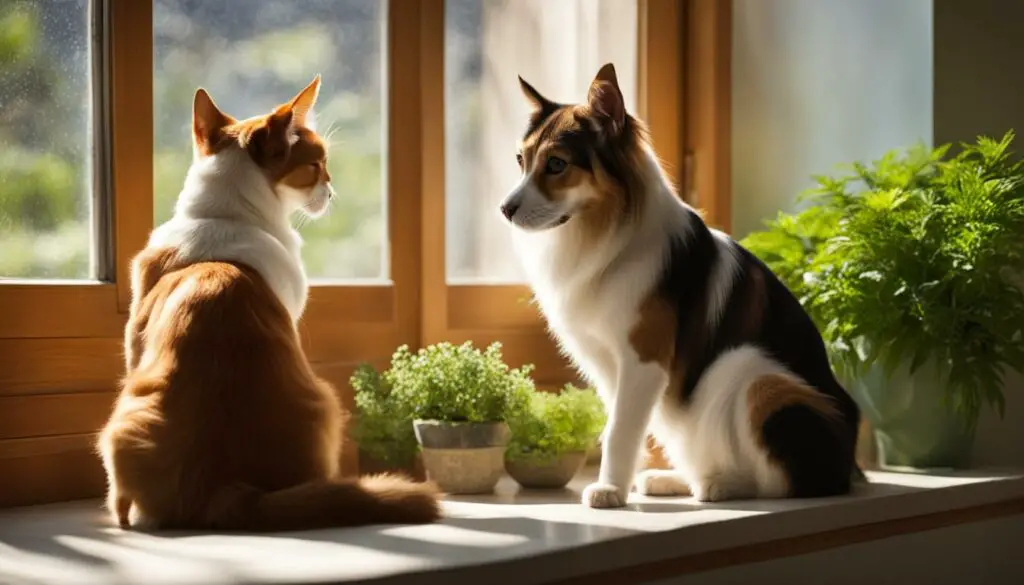
Creating a Safe Environment
In addition to the initial introduction, it’s important to create a safe environment for your cat and dog to coexist. Consider the following:
- Provide separate spaces and resources: Ensure that each pet has their own designated areas for eating, sleeping, and using the litter box or going outside.
- Use positive reinforcement: Reward both pets for calm and friendly behavior with treats, praise, and playtime. This helps create positive associations and reinforces desirable behaviors.
- Monitor their interactions: Supervise their interactions, especially during the early stages. If any signs of aggression or discomfort arise, separate them and consult a professional for further guidance.
By following these tips and providing a safe and positive environment, you can help your cat and dog build a strong and healthy relationship.
Training Your Dog for Successful Coexistence: Importance of Obedience
Proper training is crucial for ensuring a harmonious relationship between your cat and dog. Obedience training helps establish boundaries and manners, preventing any potential conflicts that may arise. By teaching your dog basic commands such as sit, stay, and leave it, you can effectively communicate your expectations and create a respectful environment for both pets.
A well-trained dog understands its place within the household and is less likely to engage in rough or aggressive behavior towards the cat. It also allows you to redirect your dog’s energy and focus onto positive activities, preventing negative interactions. Through regular training sessions and positive reinforcement, you can shape your dog’s behavior and ensure a peaceful coexistence.
Remember to be consistent with your training efforts, and always use positive reinforcement techniques such as praise, treats, and playtime to reward good behavior. This creates a positive association with the cat and encourages your dog to continue exhibiting desirable manners. With proper training, your dog can become a well-behaved companion, ultimately enhancing the relationship with your cat.
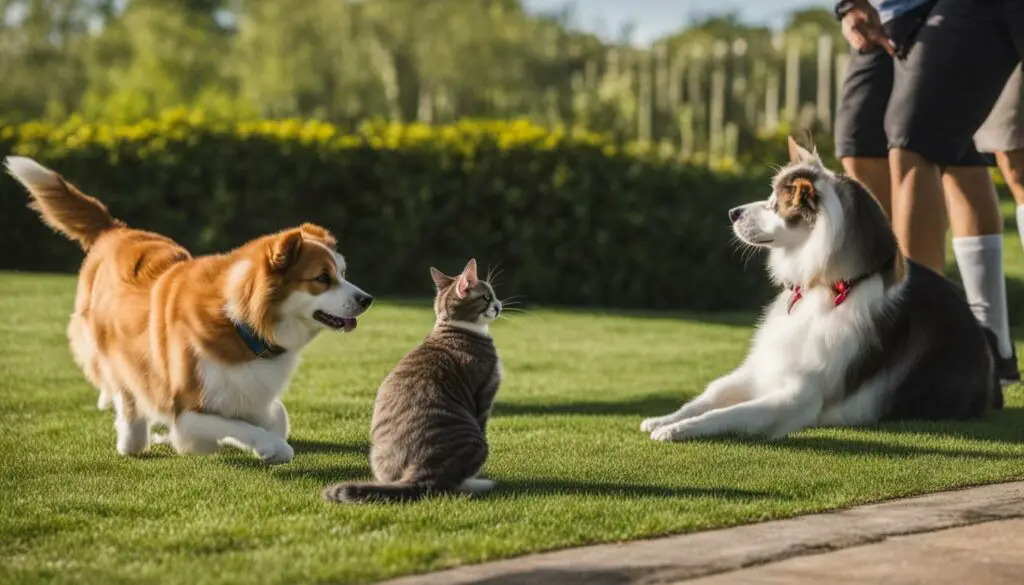
Table: Basic Obedience Commands for Dogs
| Command | Description |
|---|---|
| Sit | Teaches the dog to sit on command and wait for further instructions. |
| Stay | Teaches the dog to stay in one place until given permission to move. |
| Leave it | Teaches the dog to ignore or let go of something it wants to investigate or play with. |
| Come | Teaches the dog to come to you when called, promoting safety and control. |
| Down | Teaches the dog to lie down on command, providing a relaxed and calm posture. |
Obedience training is an ongoing process that requires time, patience, and consistency. By investing in your dog’s training, you can create a harmonious environment where both your cat and dog can coexist happily.
Exercise and Stimulation: Keeping Your Dog’s Energy Levels in Check
When it comes to ensuring a peaceful coexistence between your cat and dog, it’s crucial to address your dog’s exercise and stimulation needs. Dogs are naturally social creatures and require regular physical and mental activity to stay happy and balanced. By providing appropriate outlets for your dog’s energy, you can help minimize the chances of them overwhelming or bothering your cat.
Regular exercise is key to keeping your dog’s energy levels in check. Take your dog for daily walks to provide them with physical activity and mental stimulation. Consider engaging in interactive play sessions with your dog, using toys that encourage them to engage their brains and burn off excess energy. These activities not only tire them out but also help them develop a healthy routine.
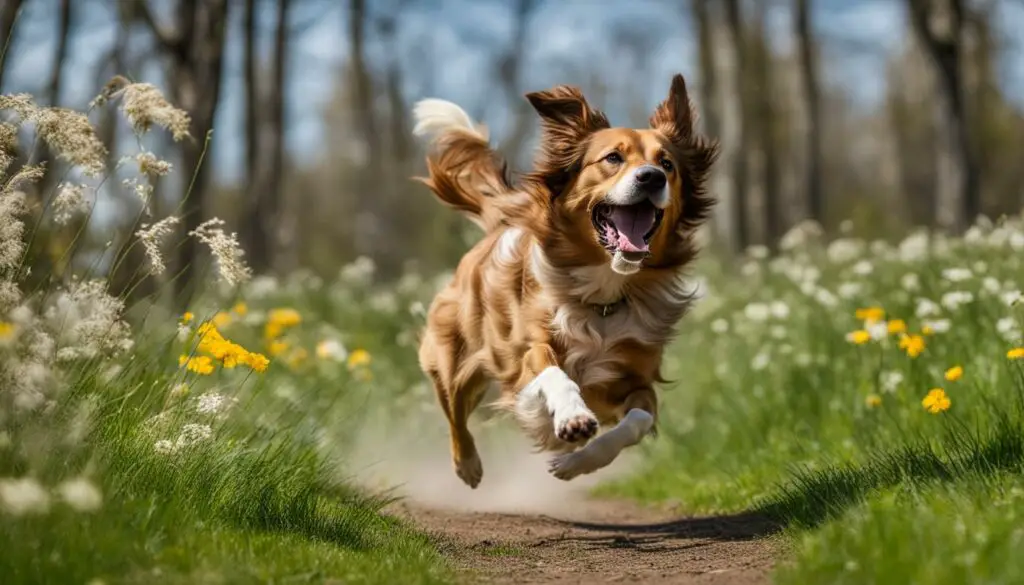
Socialization is another important aspect of keeping your dog’s energy in balance. By exposing your dog to different people, animals, and environments, you can help them become more comfortable in various situations. This helps prevent them from becoming overly excited or reactive when they encounter new stimuli, including your cat.
It’s important to note that while exercise and socialization are essential for your dog’s well-being, it’s equally important to consider your cat’s preferences. Some cats may prefer a quieter, more solitary environment and may not enjoy constant interaction with your dog. It’s crucial to respect their need for personal space and provide separate areas where they can retreat to when they need a break.
Separate Spaces and Resources: Minimizing Potential Conflicts
Creating separate spaces and providing individual resources for your cat and dog is essential for minimizing potential conflicts and promoting a harmonious coexistence between them. By establishing boundaries and ensuring each pet has their own area, you can reduce territorial behavior and the likelihood of fights. Here are key areas to consider:
Food Bowls:
Place the cat and dog’s food bowls in separate locations to prevent food guarding or competitive behaviors. This allows each pet to eat peacefully without feeling threatened or rushed. Additionally, ensure that both pets have access to fresh water throughout the day.
Litter Box:
As a separate space for the cat, the litter box should be placed in a quiet area that is inaccessible to the dog. This not only provides privacy for the cat but also prevents any potential conflicts or stress related to sharing a litter box. Regular cleaning and maintenance of the litter box are crucial for the cat’s comfort and hygiene.
Resting Areas:
Both the cat and dog should have their own designated resting areas where they can retreat to when they need some alone time. This could be a cat tree, bed, or cozy corner for the cat, and a comfortable bed or crate for the dog. Providing separate resting spaces ensures that each pet has a safe and secure area to relax without interference.
Toys and Enrichment:
Offer a variety of toys and enrichment activities for both pets, ensuring they each have their own set of playthings. This prevents potential conflicts over toys and allows each pet to engage in activities that suit their individual preferences. Rotate toys regularly to keep them mentally stimulated and prevent boredom.
By implementing these strategies and creating separate spaces and resources for your cat and dog, you can minimize potential conflicts and promote a peaceful coexistence in your home. Ensuring each pet’s comfort, privacy, and individuality sets a solid foundation for a positive relationship between your furry friends.
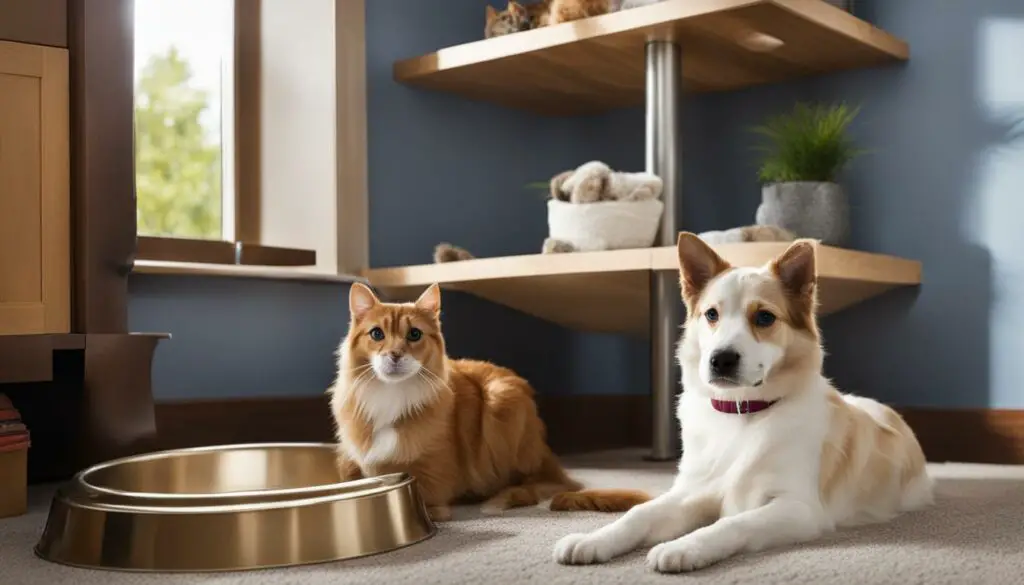
Supervision and Safety Precautions: Managing Interactions
When introducing a cat and dog to each other, it’s important to prioritize their safety and manage their interactions appropriately. Proper supervision is crucial, especially during the initial stages of their relationship. By closely monitoring their interactions, you can prevent any potential conflicts and ensure a positive and harmonious coexistence.
To manage their interactions effectively, it’s recommended to keep the pets in separate rooms or areas when you’re not able to supervise them. This helps prevent any unsupervised confrontations or accidents that may occur when they are left alone together. By providing separate spaces, you can minimize the chances of any negative encounters and provide a safe environment for both pets.
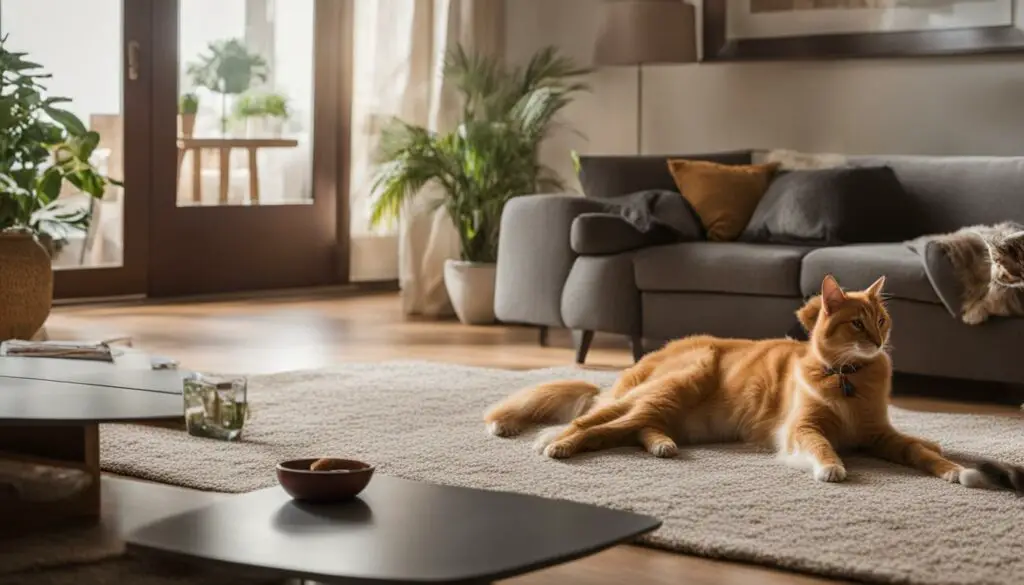
In addition to supervision, it’s important to take other safety precautions to create a secure environment for both the cat and dog. This can include using baby gates or pet barriers to separate their living spaces, ensuring that they have separate food and water bowls, and keeping their litter box in an area that is inaccessible to the dog.
In situations where the cat and dog are interacting under supervision, it’s important to set boundaries and intervene when necessary. If either pet shows signs of discomfort or aggression, redirect their attention to a positive activity or separate them temporarily. By being proactive and attentive, you can ensure the safety and well-being of both pets during their interactions.
Addressing Negative Behavior: Redirection and Positive Reinforcement
When it comes to introducing a cat and a dog, negative behavior can sometimes arise. However, it’s important to handle these situations with care and understanding. Instead of scolding or punishing your dog for rough play or chasing, it’s more effective to redirect their energy towards positive activities.
One way to achieve this is by incorporating playtime and distractions into their routine. Engage your dog in interactive play sessions using toys that provide mental and physical stimulation. This helps release their pent-up energy in a controlled manner, reducing the likelihood of them engaging in negative behaviors towards the cat.
“Playtime is a great way to redirect your dog’s focus and energy. By providing engaging toys and interactive activities, you can help them channel their natural instincts in a positive direction,” explains animal behaviorist Dr. Sarah Thompson.
“Positive reinforcement is key in addressing negative behavior. By rewarding your dog for good behavior and creating positive associations with the cat, you can encourage them to develop a more harmonious relationship,” adds Dr. Thompson.
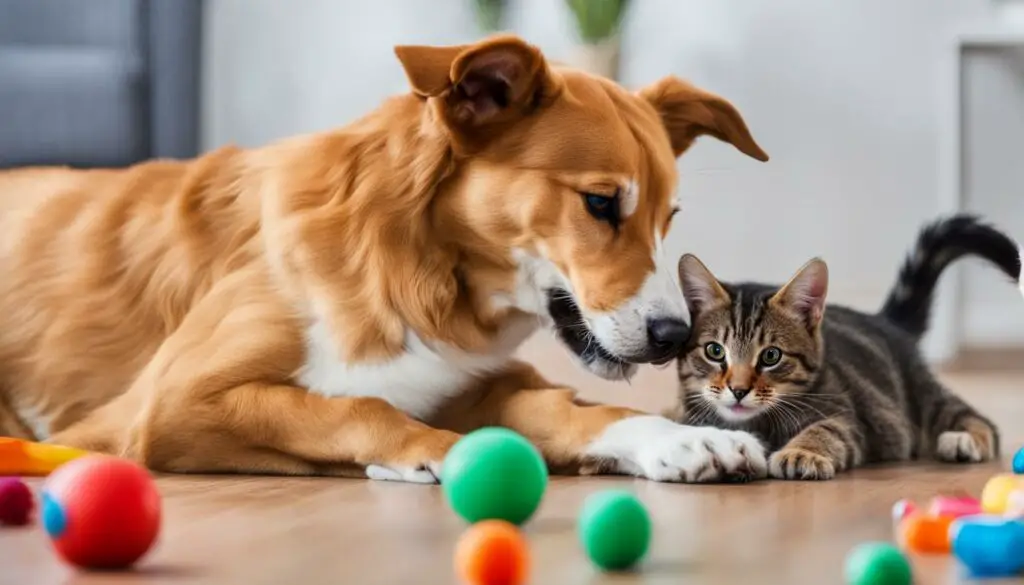
Positive Reinforcement in Action
Here’s an example of using positive reinforcement to address negative behavior:
| Cause of Negative Behavior | Action | Positive Reinforcement |
|---|---|---|
| Dog chasing the cat | Redirect the dog’s attention to a toy | Praise and reward the dog with treats when they engage with the toy instead of chasing |
| Dog growling at the cat near the food bowl | Create distance and separate feeding areas | Praise and reward the dog when they eat calmly without any aggression towards the cat |
| Dog barking at the cat during playtime | Interrupt the behavior with a command, such as “sit” or “settle” | Praise and reward the dog for obeying the command and redirect their attention to a toy or game that involves both pets |
By consistently using positive reinforcement techniques and providing alternative outlets for your dog’s energy, you can help them develop more appropriate behaviors towards the cat. Remember to be patient and consistent in your approach, as it may take time for your dog to adjust and understand what is expected of them.
Recognizing Individual Differences: Valuing Each Pet’s Preferences
When it comes to the coexistence of cats and dogs, recognizing and respecting their individual differences is crucial. Just like humans, pets have their own unique personalities and preferences. Some may enjoy constant interaction and companionship, while others may prefer their own space and independence. It’s important to value and honor these differences to ensure a peaceful and harmonious relationship between your cat and dog.
By observing your pets closely, you can learn to understand their preferences. Does your cat like to spend time perched on high surfaces, away from other animals? Does your dog prefer a quiet corner of the house to relax? Recognizing and providing for these preferences will help create a stress-free environment for both pets.
Separate interactions can also be beneficial in accommodating individual differences. While some cats and dogs may enjoy playing and cuddling together, others may find it stressful or overwhelming. Creating separate spaces for each pet where they can retreat to for alone time can help prevent conflicts and reduce stress.
Remember, just because your pets may have different preferences doesn’t mean they can’t coexist peacefully. With patience, understanding, and a willingness to adapt to their individual needs, you can create an environment where both your cat and dog feel safe, secure, and valued.
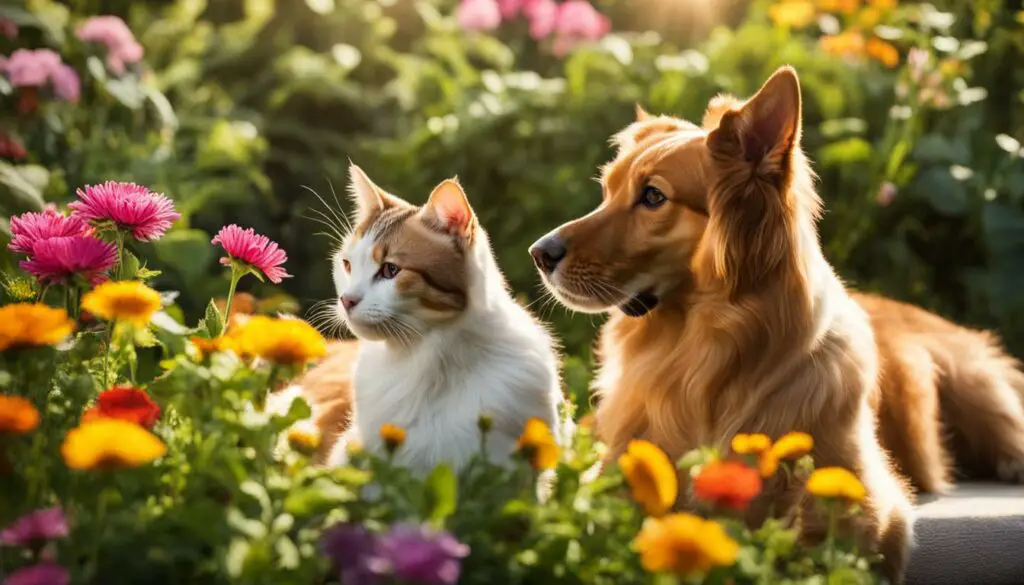
Table: Tips for Valuing Each Pet’s Preferences
| Tip | Description |
|---|---|
| Observe behavior | Pay attention to how your pets interact with each other and their surroundings to understand their preferences. |
| Create separate spaces | Provide designated areas where your cat and dog can retreat to for alone time. |
| Offer individual attention | Ensure that each pet receives individual attention and affection to meet their specific needs. |
| Provide enrichment | Offer toys, scratching posts, and other forms of enrichment to cater to their individual interests. |
By valuing and accommodating the individual preferences of your cat and dog, you can foster a positive and harmonious coexistence between them. Remember, every pet is unique, and respecting their differences is key to creating a loving and peaceful home environment.
Seeking Professional Help: Consulting an Animal Behaviorist or Veterinarian
If you’re facing challenges in getting your cat and dog to get along, it can be beneficial to seek professional help. Consulting an animal behaviorist or veterinarian with expertise in pet behavior can provide valuable advice and guidance. These professionals can assess the unique dynamics between your pets and offer tailored strategies to improve their relationship.
An animal behaviorist specializes in understanding and modifying animal behavior. They can provide insights into the underlying causes of conflicts and offer behavior modification techniques to address negative behaviors. With their expertise, they can help you implement effective training methods and establish a harmonious environment for your cat and dog.
A veterinarian with a focus on pet behavior can also provide valuable assistance. They can rule out any underlying medical issues that may be contributing to the tensions between your pets. Additionally, they can offer guidance on managing interactions, training techniques, and ensuring the overall well-being of both your cat and dog.
Professional help can make a significant difference in resolving conflicts and creating a positive environment for your furry friends. They have the knowledge and experience to assess the unique dynamics between your cat and dog and provide effective solutions. Don’t hesitate to reach out to an animal behaviorist or veterinarian if you’re experiencing difficulties. They can offer the guidance and support you need to foster a harmonious relationship between your pets.
| Professional Help: Benefits and Services | Animal Behaviorist | Veterinarian |
|---|---|---|
| Expertise in animal behavior and modification techniques | Yes | Yes |
| Insights into underlying causes of conflicts | Yes | Yes |
| Behavior modification strategies | Yes | No |
| Medical evaluation and advice | No | Yes |
| Training techniques and guidance | Yes | Yes |
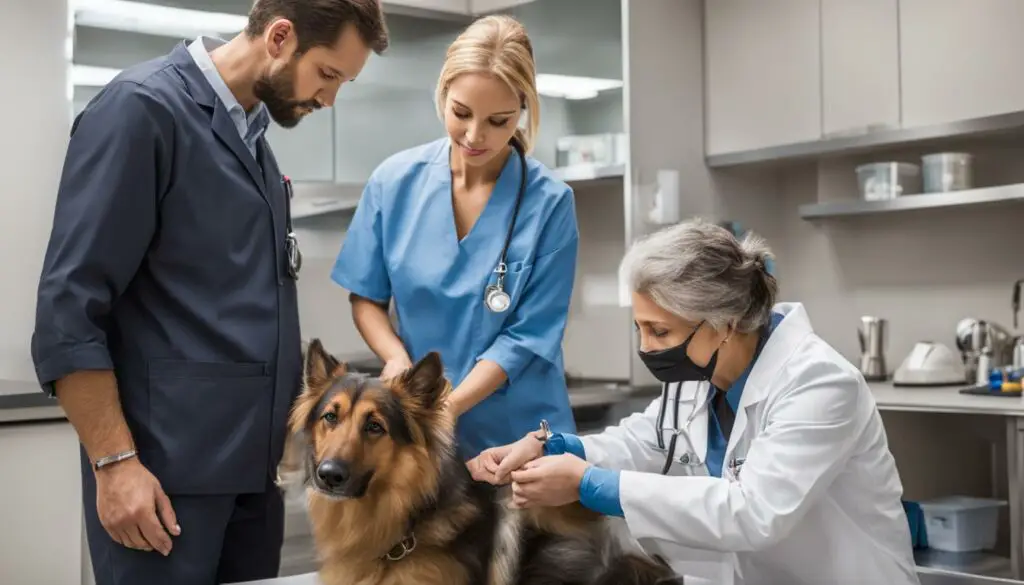
“Seeking professional help can be a game-changer when it comes to resolving conflicts between a cat and a dog. An animal behaviorist or veterinarian can provide expert insights and tailored strategies to improve their relationship. Don’t hesitate to reach out for assistance – their guidance can make a world of difference!”
Conclusion
In conclusion, achieving a harmonious coexistence between cats and dogs is indeed possible. By considering the individual personalities of your pets, following proper introduction protocols, and providing separate spaces and resources, you can increase the chances of a positive relationship. Remember to be patient, as it may take time for them to adjust to each other.
Throughout this article, I have provided you with valuable tips and guidelines to help foster a peaceful bond between your cat and dog. It’s crucial to recognize and respect their unique preferences and needs, allowing them to interact at their own pace. By doing so, you can create a harmonious environment where both pets can thrive.
If you encounter difficulties or have any concerns, don’t hesitate to seek professional help. An animal behaviorist or veterinarian specialized in pet behavior can offer expert advice and guidance tailored to your specific situation. Remember, there are resources available to assist you in navigating the challenges and ensuring the well-being of your furry companions.
In conclusion, with the right approach, patience, and understanding of their individual needs, your cat and dog can develop a beautiful and lasting friendship. Follow the tips provided in this article, seek professional help when necessary, and create a loving and harmonious coexistence between your pets.
FAQ
Will my cat and dog ever get along?
It is possible for cats and dogs to have a harmonious relationship, but it depends on their individual personalities and how they are introduced and managed by their owners.
Do cats and dogs get along?
Cats and dogs can get along, but it relies on their personalities and how they are trained and managed by their owners.
What are some dog breeds that can live with cats?
Golden Retrievers, Pugs, and Basset Hounds are examples of cat-friendly dog breeds that are known for being more compatible with feline friends.
How do I introduce my dog and cat to each other?
Start by allowing them to get familiar with each other’s scent and provide separate spaces. Gradually allow controlled visual interactions while keeping them separated. Gradual introductions help both pets adjust and become familiar with each other’s presence.
How can I ensure a positive first meeting between my cat and dog?
Keep them separated in different parts of the house initially. Start by allowing them to see and smell each other through a door while they are being fed. Gradually increase their visual interactions with a dog gate between them. Supervise the meeting, keeping the dog on a leash and ensuring the cat is relaxed and secure.
Is obedience training important for dogs to live with cats?
Yes, proper training is essential for a dog to coexist peacefully with a cat. Teaching them basic obedience commands helps establish boundaries and manners and prevents rough or aggressive behavior.
How can I keep my dog’s energy levels in check to prevent them from bothering the cat?
Providing enough physical and mental exercise for your dog, such as daily walks and interactive play sessions, helps lower their energy levels and prevents them from overwhelming the cat.
How can I minimize potential conflicts between my cat and dog?
Provide separate spaces and resources for each pet, such as separate food bowls and a quiet area for the litter box. This helps prevent territorial behavior and fights.
Should I supervise interactions between my cat and dog?
Yes, it’s important to supervise interactions between a cat and a dog, especially during the initial stages of their relationship. Keep them separated when you’re not able to supervise them to prevent any potential conflicts.
What should I do if my dog displays negative behavior towards the cat?
Instead of scolding or punishing the dog, redirect their energy towards positive activities and use obedience training to redirect their focus. Positive reinforcement should be used to reward good behavior and create positive associations with the cat.
What if my pets prefer their own space and don’t enjoy constant interaction?
It’s essential to respect and value these differences. Give them the space they need and separate them from other pets as much as possible. Allowing them to exist in the same household without constantly pushing their interactions can eventually lead to a peaceful coexistence.
Should I seek professional help if my cat and dog are not getting along?
If you’re experiencing difficulties, it’s a good idea to seek professional help. An animal behaviorist or veterinarian with expertise in pet behavior can provide valuable advice and guidance to improve their relationship.
What should I do to ensure a harmonious coexistence between my cat and dog?
Consider their personalities, follow proper introductions, provide separate spaces and resources, and seek professional help when needed. Be patient and value each pet’s preferences to create a positive and peaceful coexistence.

